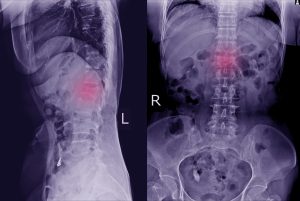 Spinal fractures are serious injuries that need to be examined and monitored by a doctor. Even if symptoms are not severe, you should consult an orthopedic doctor to prevent further damage to the spine or nerves. There are three types of spinal fractures: compression, distraction, and rotation.
Spinal fractures are serious injuries that need to be examined and monitored by a doctor. Even if symptoms are not severe, you should consult an orthopedic doctor to prevent further damage to the spine or nerves. There are three types of spinal fractures: compression, distraction, and rotation.
Compression Fractures
A compression fracture occurs when part of a vertebra collapses. According to the American Academy of Orthopedic Surgeons, vertebral compression fractures occur in around 700,000 patients each year. Compression or flexion fractures most often occur in the thoracic and lumbar spine.
The most common type of vertebral compression fracture (VCF) is a wedge fracture, in which the front of the vertebra breaks, but the back does not, creating a wedge shape. The other type of VCF is the axial burst fracture, in which the vertebra collapses in both the front and back.
Symptoms
Vertebral compression fractures cause back pain in the area of the affected vertebra. In rare cases, pain caused by a compression fracture may move into the abdomen or into the legs. Movement often increases pain, which is sometimes relieved by rest. If left untreated, individuals with VCF may notice a loss in height.
Causes
Osteoporosis makes patients more vulnerable to spinal fractures. When bones are very weak and brittle, they can be fractured during everyday activities like lifting lightweight objects, walking up steps, or even sneezing. In people with healthy spines, compression fractures usually occur after severe trauma such as a fall or car accident. Cancer that spreads to the bone may weaken the vertebra, which can cause collapse.
Treatment
Compression fractures often heal without surgical intervention to repair the fractures. Nonsurgical treatments include rest, pain medication, and braces to restrict movement. If pain persists after nonsurgical treatments, surgical options can be explored. The two surgical procedures performed to treat compression fractures are:
- Kyphoplasty: The surgeon inserts a needle into the fractured vertebra with x-ray guidance. A balloon device is inserted into the vertebra through the needle and is carefully inflated. The inflated balloon increases vertebral height and restores shape. The balloon is deflated and removed, leaving a cavity that the surgeon will fill with bone cement to strengthen the vertebra.
- Vertebroplasty: A vertebroplasty is similar to kyphoplasty but does not include the balloon device. The surgeon inserts bone cement directly into the affected vertebra. Both procedures are non-invasive and patients can return to normal activities very soon after surgery.
Flexion-Distraction Fracture
A flexion-distraction, or Chance, fracture occurs when the vertebrae are pulled apart (distraction) during a severe trauma like a head-on car collision. The bone and ligaments may both be involved. If the ligaments are involved it is more difficult to heal.
Symptoms
A distraction fracture is a serious injury and causes severe back pain. The pain will worsen with movement. High-force crashes like the ones that cause distraction fractures may also cause brain injuries and loss of consciousness. You should seek treatment immediately if you aren’t taken to the ER by emergency services.
Causes
Distraction fractures are sometimes called a seatbelt fracture because they can occur in head-on car accidents when the upper body is thrown forward while the lower half of the body is held in place by the lap part of the seat belt. Proper use of a shoulder belt can help reduce the risk of a Chance fracture.
Treatment
The nonsurgical treatment for a Chance fracture is immobilization in a cast or brace. These fractures often require surgery for decompression and stabilization. Surgical procedures include vertebrectomy and fusion or grafting.
Rotation Fractures
There are two types of rotation fractures:
- Transverse process fracture: This uncommon fracture is caused by extreme lateral bending or rotation of the spine. It does not usually affect the stability of the spine.
- Fracture-dislocation: This type of fracture involves both bone and soft tissues and is highly unstable. The vertebra may be displaced or dislocated by a high-force trauma. Fracture-dislocations often lead to spinal cord or nerve damage.
Causes
Rotation fractures may be caused by the spine rotating or bending. Fracture-dislocations are usually the result of a high-force trauma like a car accident.
Treatment
Transverse process fractures can be treated nonsurgically with rest and gradually increased movement. A brace may be used. Fracture-dislocations require surgery for stabilization.
—
Dr. Nael Shanti of Cary Orthopaedics Spine Center is a board-certified orthopedic surgeon specializing in minimally invasive spine surgery. Dr. Shanti treats a wide range of back injuries and conditions, including spinal fractures. If you have questions about spinal fractures or minimally invasive spine surgery, call (919) 297-0000 to make an appointment with Dr. Shanti.
